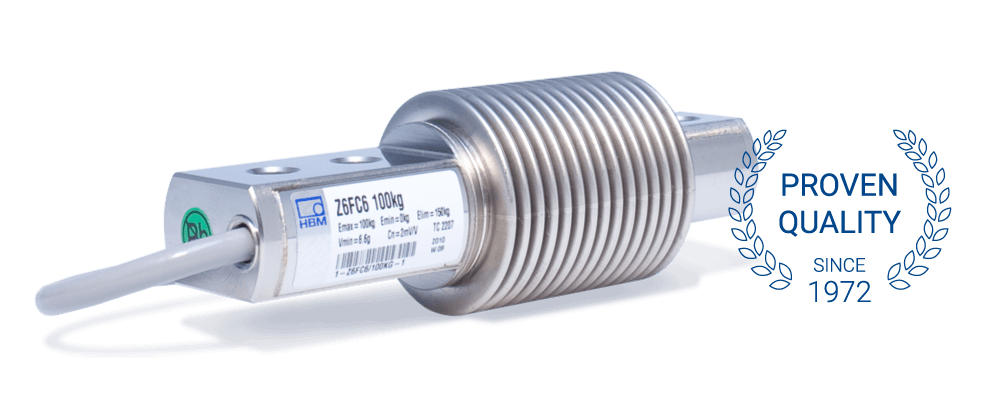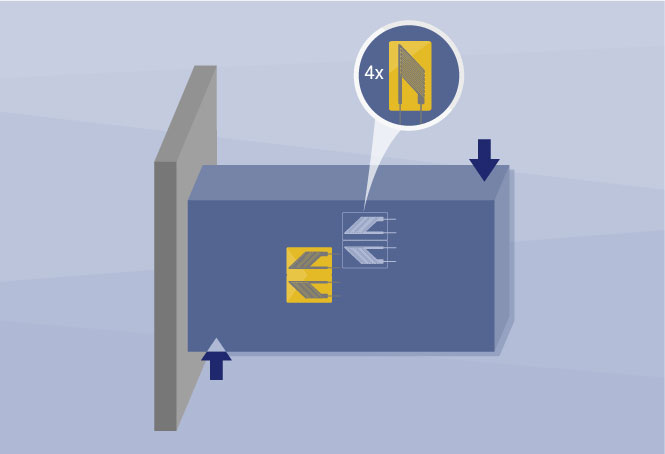How Does a Bending Beam Load Cell Work?
During a measurement, weight acts on the load cell's metal spring element and causes elastic deformation. This strain (positive or negative) is converted into an electrical signal by a strain gauge (SG) that is installed on the spring element. The simplest type of load cell is a bending beam with a strain gauge. Often, the (mandatory) basic components, i.e. spring element and strain gauge, are complemented with additional elements (housing, sealing elements, etc.) protecting the strain gauge elements.
Single Bending Beam Load Cells
Bending beam load cells are the best fit for many measuring tasks. Here, the signal, on principle, depends on the bending moment. When the load application point in the bending beam's longitudinal direction changes with identical loads, different signals are generated. For this reason, the single bending beam is rarely used in load cells, because it requires special measures to ensure a constant load application point (lever arm effect).

Fig. 1: Double bending beam principle

Multiple Bending Beam Load Cells
Multiple bending beams are often used as spring elements for loads up to 5 t. This load cell type mainly uses two (double bending beam) or three (triple beam) bending beams. They are coupled via rigid elements on the clamping and on the load application side. The rigid coupling enforces a purely vertical shift of the load application point and an S-shaped deformation of the two beams. This system is significantly less sensitive to load application point shifts than a single bending beam. The S-shaped deformation generates positive and negative strain zones on the surface, which are close to each other and considerably facilitate strain gauge installation and wiring. Figure 2 shows different double bending beam types.
Fig. 2: Double bending beam types
HBM Bending Beam Load Cells
HBM's range of load cell types uses various modifications of bending beams. They are employed in tank weighing, plant engineering, and process weighing applications. Many of these multiple bending beam load cells have been approved, for instance, by the German National Metrology Institute (PTB), for integration into scales that are used in legal-for-trade applications or potentially explosive atmospheres. Certificates for worldwide use are available as well. Z6 and HLC are typical bending beam load cells from HBM. The differences are as follows:
Z6/Z6R Load Cells
These cylindrical load cells are widely used. Z6 was developed by HBM in 1972 and has become established as the standard, with millions of units produced worldwide. The load cell, with maximum capacities ranging from 5 kg to 1 t, is employed in platform and conveyor scales for dosing and level measurement as well as for weighing modules that, for instance, are used for tank weighing applications. The sensitive measuring element is protected by the characteristic metal bellows.
The legal-for-trade Z6R bending beam load cell has been designed for maximum capacities ranging from 20 to 200 kg and is mechanically and electrically compatible with the Z6. It has been specially developed for use in applications with strict hygiene requirements or harsh environments. Unlike the Z6, its design does not involve a bellows but a hermetically sealed measuring body, without gaps or edges, which is particularly easy to clean.
With the Z6/Z6R load cells, the strain gauges are installed on the plane surface in the strain zone (above or below the two through-holes) (see picture 1 or 2 [depending on the maximum capacity] in figure 2). The strain zone is then hermetically sealed by a welded stainless-steel bellows (Z6) or a robust stainless-steel tube (Z6R).


HLC Load Cells
These cuboid load cells are available with maximum capacities ranging from 110 kg to 10 t. They are employed in tank, dosing, and platform weighers as well as in level monitoring. With the HLC load cells, the strain gauges are installed in the measuring element’s through hole (see the last picture in figure 2). This zone is hermetically sealed by welded stainless-steel cups.

Other Designs
Besides bending beams, there are various other load cell designs. These include, for instance:
Load Cells for Tensile/Compressive Loading
Tension load cells allow weighing of suspended loads such as tanks. Typical applications include gravimetric level measurement or dosing applications with suspended process tanks. Compression load cells measure applied loads, for instance, in vehicle scales, silo, and ladle weighing or batching scales.
Shear Beam Load Cells
Shear beam load cells offer excellent stability in the case of lateral forces. Shear strains do not vary when the load application point moves within a certain range. Hence, the electrical signal that is proportional to the applied load is independent of the load application point. However, secondary effects can impact the measurement result.
Special Designs such as Ring Torsion Load Cells
Ring torsion load cells are very small and can, therefore, be employed in many different weighing applications. Their robust design ensures favorable installation and operating conditions even in harsh environments (aggressive media, interference, temperature variations). Load cells based on this principle, withstand higher lateral loads.







